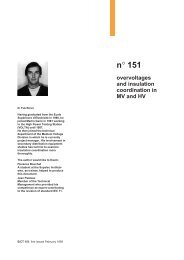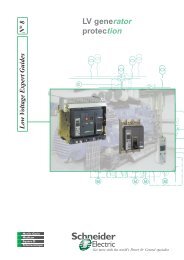sepam 20 user manual - Schneider Electric
sepam 20 user manual - Schneider Electric
sepam 20 user manual - Schneider Electric
Create successful ePaper yourself
Turn your PDF publications into a flip-book with our unique Google optimized e-Paper software.
3<br />
Protection functions Starts per hour<br />
ANSI code 66<br />
3/30<br />
Operation<br />
This function is three-phase.<br />
It picks up when the number of starts reaches the following limits:<br />
b maximum number of starts allowed per period of time (P) (Nt)<br />
b maximum allowed number of consecutive hot starts (Nh)<br />
b maximum allowed number of consecutive cold starts (Nc).<br />
The function indicates:<br />
b the number of starts still allowed before the maximum, if the protection has not<br />
picked up. The number of starts depends on the motor’s thermal state<br />
b waiting time before a start is allowed, if the protection has picked up.<br />
Starting is detected when the current consumed becomes greater than 10 % of the<br />
Ib current.<br />
User information<br />
The following information is available for the <strong>user</strong>:<br />
b the waiting time before a start is allowed<br />
b the number of starts still allowed.<br />
See chapter "Machine operation assistance functions".<br />
MT10871<br />
The number of consecutive starts is the number starts counted during the last P/Nt<br />
minutes, Nt being the number of starts allowed per period.<br />
The motor hot state corresponds to the overshooting of the fixed set point (50 % heat<br />
rise) of the thermal overload function.<br />
When the motor re-accelerates, it undergoes a stress similar to that of starting<br />
without the current first passing through a value less than 10 % of Ib, in which case<br />
the number of starts is not incremented.<br />
It is possible however to increment the number of starts when a re-acceleration<br />
occurs by a logic data input (input I22).<br />
Block diagram<br />
I1<br />
I2<br />
I3<br />
I > 0.1Ib<br />
input I22<br />
0<br />
Characteristics<br />
T<br />
thermal alarm<br />
(hot state)<br />
&<br />
"Clear"<br />
≥ 1<br />
Period of time (P)<br />
Setting 1 to 6 hr<br />
Resolution 1<br />
Nt total number of starts<br />
Setting 1 to 60<br />
Resolution 1<br />
Nh and Nc number of consecutive starts<br />
Setting (1) 1 to Nt<br />
Resolution 1<br />
T time delay between starts<br />
Setting 0 mn y T y 90 mn (0: no time delay)<br />
Resolution 1 mn or 1 digit<br />
(1) With Nc y Nf.<br />
&<br />
k1 > Nt<br />
P mn<br />
k2 > Nc<br />
P mn/Nt<br />
k3 > Nh<br />
P mn/Nt<br />
≥ 1 inhibit<br />
closing<br />
PCRED301005EN - 06/<strong>20</strong>08

















